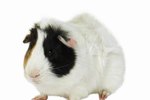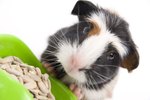
The Patagonian cavy, also known as the Patagonian mara, is a large-sized relative of the guinea pig species. Adults typically weigh 15 to 30 pounds, but this can rise to 35 pounds. A native of Argentina, the species has near-threatened status. Cavy babies are suitable for bottle-feeding and are known to bond well with humans. Caring for them is relatively simple, but you need some outdoor space to house your rabbitlike Patagonian cavy.
Reproduction
A female cavy reaches sexual maturity at 8 months. In captivity she can have three to four litters annually, but in the wild she tends to have just one. Litters count between one and three babies. The gestation period is an average of 100 days, and the majority of pups are born between August and December. The mother nurses her pups in a den for 75 to 78 days, although she doesn't spend all her time with them: Typically she returns to the den just to feed them. Male cavies make no contribution to baby care. Babies can be homed at three weeks. Babies need homes as young as possible so that they bond with owners. Early socialization with humans helps the babies grow into calm, tame pets.
Feeding
Baby cavies born in captivity respond well to bottle-feeding before weaning. Ask the breeder for advice about which animal-milk replacement to use, and the quantities and number of feedings required daily. Milk replacers are available for several creatures but not all species; you need one for a herbivorous animal with a low protein requirement. When the baby is ready to move to solid food, a weaning milk formula can help with the transition. A typical adult cavy diet consists of timothy grass or a blend of hay and alfalfa. You can supplement this diet with guinea pig pellets to increase his vitamin C intake, according to Cedar Falls breeders. Lettuce leaves and vegetables are good for them; they can eat a small amount of fresh fruit.
Housing
Keep a baby cavy confined to the house until he is fully grown. It is possible to potty train a cavy using newspaper and a litter tray. Place the paper or tray near his food: Cavies usually potty near their eating area. You can expect him to do this when you bottle-feed him, so keep paper towels handy. Baby cavies like to chew. It is not as easy to stop him doing this as it would be a puppy. It is preferable to keep an adult cavy outdoors in a large pen with a dog kennel inside. A cavy is a great runner and jumper, so you need to make sure the enclosure wire is at least 6 feet high. The kennel should measure 10 feet by 10 feet. Provide heat in cold weather and shade in the heat.
Teeth and General Care
Like other rodents', the cavy's teeth keep growing throughout his life. You need to provide your cavy with something he can grind down his teeth with. Cedar Falls Exotics suggests an apple tree branch for gnawing. Placing some large stones in his enclosure offers him something to trim his teeth on. Spend as much time as possible petting and playing with your baby cavy. You can even train him to go for walks on a harness or leash. Take care to protect him from large dogs if you do take him on a walk.
References
Resources
Photo Credits
-
Goodshoot/Goodshoot/Getty Images
Writer Bio
Based in London, Eleanor McKenzie has been writing lifestyle-related books and articles since 1998. Her articles have appeared in the "Palm Beach Times" and she is the author of numerous books published by Hamlyn U.K., including "Healing Reiki" and "Pilates System." She holds a Master of Arts in informational studies from London University.




